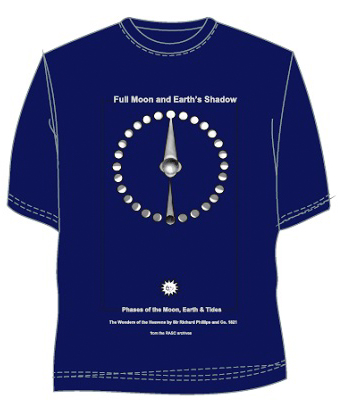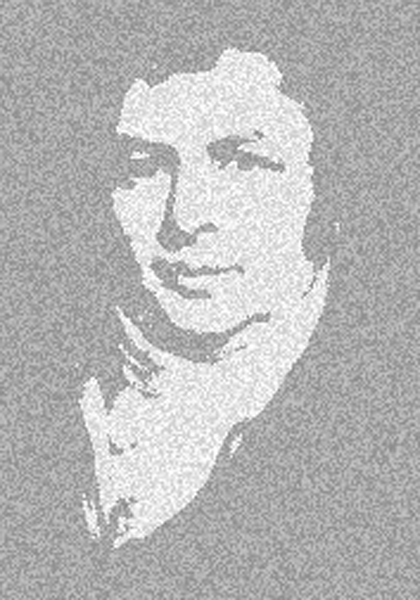 This shirt is no longer available.
This shirt is no longer available.
The new limited-run “vintage” RASC t-shirt features an image from the Society’s rich archives. The striking design is an evocative invitation to an astronomical past which has shaped where we are today, and whose traces can still be seen in our science.
 The image was published in Sir Richard Phillips, The Wonders of the Heavens Displayed, in Twenty Lectures... with numerous engravings (London: Sir Richard Phillips and Co., 1821). It appeared the year after the founding of the Astronomical Society of London (the future Royal Astronomical Society, which had its start, fittingly enough, in a tavern). “Sir” William Herschel, KH, (1738-1822) was still alive, his son John Herschel (1792-1871) was awarded the Copley Medal of the Royal Society, and was commencing his important double-star catalogue with James South (1785-1867), a man equal to Sir Richard Phillips in irascibility. Only four asteroids had been discovered―1 Ceres in 1801 (now a dwarf planet), 2 Pallas also in 1801 (presently a dwarf-planet candidate), 3 Juno in 1804, and 4 Vesta in 1807―a far cry from the 1,000,000+ known at present. The Marquis de Laplace (1749-1827) was still in the process of publishing his Traité de mécanique céleste (1798-1827), the latest refinement and extension of continental Newtonianism, and in three years time Josef von Fraunhofer’s (1787-1826) Great Dorpat Refractor would be installed for F.G.W. Struve (1793-1864) to begin his dynasty’s astrometric assault on the Heavens. William Parsons (1800-1867)―Lord Rosse―future builder of the Leviathan of Parsonstown (1845, a telescope with an aperture in the same class as the Plaskett and David Dunlap Telescopes), and discoverer of spiral nebulae (now galaxies, in 1845), was elected to the House of Commons for the first time in 1821. And, looking to the future, in that year were born Wilhelm Tempel (1821-1889), the man who visually discovered nebulosity in the Pleiades (1859), and Edwin Dunkin (1821-1898), Greenwich astronomer, noted populariser, and bon vivant. Some of our current astronomical terms―"asteroid", "planetoid"―date from this period (late 18th-early 19th centuy), as do catalogues which lie behind those we currently use, as well as object designations (e.g., Messier catalogues of nebulae and star clusters→Herschel catalogues of nebulae and star clusters→Dreyer NGC & IC catalogues→Sinnott NGC 2000.0→Steinicke RNGC/IC).
The image was published in Sir Richard Phillips, The Wonders of the Heavens Displayed, in Twenty Lectures... with numerous engravings (London: Sir Richard Phillips and Co., 1821). It appeared the year after the founding of the Astronomical Society of London (the future Royal Astronomical Society, which had its start, fittingly enough, in a tavern). “Sir” William Herschel, KH, (1738-1822) was still alive, his son John Herschel (1792-1871) was awarded the Copley Medal of the Royal Society, and was commencing his important double-star catalogue with James South (1785-1867), a man equal to Sir Richard Phillips in irascibility. Only four asteroids had been discovered―1 Ceres in 1801 (now a dwarf planet), 2 Pallas also in 1801 (presently a dwarf-planet candidate), 3 Juno in 1804, and 4 Vesta in 1807―a far cry from the 1,000,000+ known at present. The Marquis de Laplace (1749-1827) was still in the process of publishing his Traité de mécanique céleste (1798-1827), the latest refinement and extension of continental Newtonianism, and in three years time Josef von Fraunhofer’s (1787-1826) Great Dorpat Refractor would be installed for F.G.W. Struve (1793-1864) to begin his dynasty’s astrometric assault on the Heavens. William Parsons (1800-1867)―Lord Rosse―future builder of the Leviathan of Parsonstown (1845, a telescope with an aperture in the same class as the Plaskett and David Dunlap Telescopes), and discoverer of spiral nebulae (now galaxies, in 1845), was elected to the House of Commons for the first time in 1821. And, looking to the future, in that year were born Wilhelm Tempel (1821-1889), the man who visually discovered nebulosity in the Pleiades (1859), and Edwin Dunkin (1821-1898), Greenwich astronomer, noted populariser, and bon vivant. Some of our current astronomical terms―"asteroid", "planetoid"―date from this period (late 18th-early 19th centuy), as do catalogues which lie behind those we currently use, as well as object designations (e.g., Messier catalogues of nebulae and star clusters→Herschel catalogues of nebulae and star clusters→Dreyer NGC & IC catalogues→Sinnott NGC 2000.0→Steinicke RNGC/IC).

“Canada” was not entirely astronomically dead in the 1820s. The indefatigable David Thompson (1770-1857) was employed as "Astronomer and Surveyor Under the 6th and 7th Articles of the Treaty of Ghent", and l'abbé Jérôme Demers (1774-1853) was teaching astronomy at the Petit Séminaire de Québec.
The Wonders of the Heavens is a hefty duodecimo tome (think of a very thick modern paperback), liberally illustrated with engravings of high artistic quality, strong opinion cloaking occasionally dodgy scientific explanations, and probably too much self-conceit for anyone’s good. Consequently it sold well, going through at least six printings in its first year. The book seemed to mirror both the physical from of its author, as well as his opinions.
The image reproduced on our t-shirt can be found between pages 174 and 175, in a chapter dealing with “the Moon and its orbit”. At the top the print is inscribed “Full Moon & Earth’s Shadow”, on the right margin “First Quarter”, on the left margin “Last Quarter”, and a little further down the page “New Moon & its Shadow”, and in the bottom margin “Phases of the Moon Earth & Tides”. The geometry of the shadow cone extending from the Earth at full Moon is hardly the last word in accuracy, add to which the text makes no mention of eclipse phenomena; this detail of the image certainly calls for commentary, but, alas, Phillips affords it none. And the curious tidal bulges on the Earth are graphically balanced, if scientifically rather unfortunate―an aspect Phillips acknowledges.
Phillips’ explanation of the plate occurs at pages xxii-xxiii (note the shaky grasp of the principles of Newton’s legacy, which he elsewhere disputed):
“Plate IV.―The Phases of the Moon.
The student will readily understand this plate, when he considers, that the Moon derives the whole of its lights from the Sun, and that the quantity of the lunar illumination necessarily depends on the Moon’s position with regard to the Earth, the whole of the illumined side being presented to the Earth when the Moon is on the opposite side, and the whole of the dark side being presented to us when the Moon is on the nearer side. The projections on the Earth’s surface are intended as a rude representation of the tides, or of the effect produced on the moveable portions of the Earth by the action and re-action of the Moon, by which they perform orbits reciprocally as their masses, round their common fulcrum”.
 What more do we know about this author? Rather a lot, as it turns out. His was a rags to riches story.
What more do we know about this author? Rather a lot, as it turns out. His was a rags to riches story.
Phillips was born in 1767 to a Leicestershire farmer, and after a spotty education and various business ventures and debacles, found his calling as a stationer who, besides operating a printing press, also sold “pianofortes, music, caricatures, and prints”, and ran “a circulating library” (―nothing like diversification). His prosperity was really due to his publishing activities. He held a brief for the poor and the downtrodden, and kept quite radical company, publishing Tom Paine’s Rights of Man, which landed him a year and a half in the county gaol. No matter, he was able to run his publishing ventures from that involuntary hostelry, gaining the acquaintance and aid of the great natural philosopher and “lunatick”, the rev’d Dr. Joseph Priestley of Birmingham (1733-1804). Despite his lifelong radical and republican leanings, Phillips became sheriff of London in 1807, and remarkably enough, in 1808 was knighted by that notable amateur astronomer, George III (1738-1820). Phillips lived on till 1840, through two more reigns and into a third.
One Scottish commentator remarked of Phillips that he was “‘a dirty little Jacobin’, with no literary ability and absurd scientific views” (to a British Tory of the time "Jacobin" was as fine an insult as one could wish to hurl at an opponent) . Augustus de Morgan (1806-1871), mathematician, member of the Royal Astronomical Society, and publisher of the immortal “The Astronomer's Drinking Song” (ca. 1866), on the topic of Phillips “credited him with honesty, zeal, ability, and courage, but adds that ‘he applied them all in teaching matters about which he knew nothing’, and so made himself ridiculous”. At least he could commission artistically striking astronomical designs, which can be appreciated in our day. Wear the t-shirt with pride―and if anyone asks about the image, you’ll have entertaining stories to tell about how astronomy has changed over the intervening two centuries, and how it hasn't.
R.A. Rosenfeld, RASC Archivist
Note: the Archivist admits to having "improved" the image on the t-shirt by adding Phillips' features to the Sun, in homage to standard scientific anthropomorphized solar depictions of the Enlightenment. Perhaps Phillips would not have been displeased.
| Attachment | Size |
|---|---|
| 3.39 KB |
